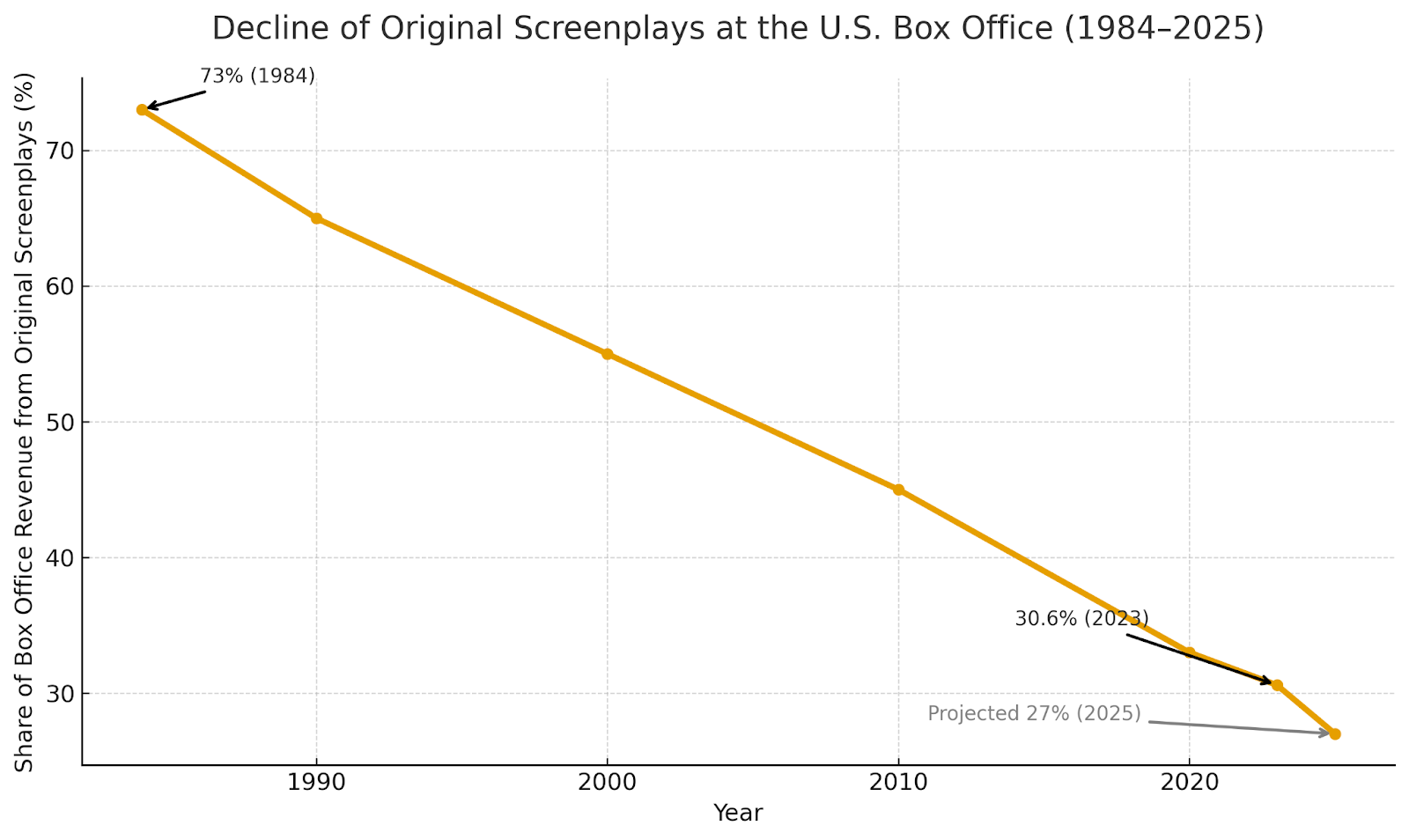Hollywood’s Next Financier: You
Hollywood has hit a breaking point. Audiences are fatigued by franchise sequels and reboots. YouTube has overtaken Disney as the world’s largest distributor. And Gen AI tools like Sora 2 can soon turn anyone into a filmmaker. Yet one thing hasn’t changed: how films get financed. And that’s why we keep getting fewer original films.

Decline of original screenplays at the US box office (1984-2023)
Source: The Numbers and Box Office Mojo
For decades, filmmakers have had only two ways to raise capital: courting wealthy “patrons of the arts” or signing away IP in restrictive studio deals. These small circles still control who the next David Lynch will be, or which film becomes the next Napoleon Dynamite, while everyday fans — the people who live and breathe these films — have never had a seat at the table. (Fewer than 1% of Americans meet SEC “accreditation” standards to invest in most private ventures, including film.)
That’s finally changing, thanks to tokenization. The promise of "decentralization in film” has arrived, quietly and legally this time. A few years ago, “Web3 Film” had the right dream but the wrong tools: people were slicing films into NFT frames, touting complex tokenomics and skirting securities laws. None of it worked. Projects like Stoner Cats, Ashton Kutcher’s NFT cartoon, became cautionary tales after the SEC cracked down for selling unregistered securities to unaccredited investors.
Today, the difference is compliance. Through licensed platforms operating under SEC exemptions such as Reg CF, production companies can take on thousands of unaccredited investors (even in the U.S.) to back real film projects and share in the upside. Security tokens issued on blockchain rails make it possible to distribute dividends transparently and cost-effectively — and, eventually, trade investors’ stakes on secondary markets.
And it’s already working. Tens of thousands of investors have contributed more than $30 million to premium productions from some of Hollywood’s most respected names. This year, Robert Rodriguez (Sin City, Spy Kids) raised $2 million from 2,000 fans to invest in new action films — and every investor got to pitch him a film as part of the slate. Pressman Film — the company behind American Psycho, Wall Street and The Crow —raised $2 million for a slate of bold, original films, and is already starting to return capital within six months. And Eli Roth (Hostel, Inglorious Basterds) launched a fan-owned horror studio that maxed out its $5 million Reg CF campaign in July. He was tired of studios deeming his ideas too gory, even though the most profitable film of 2024 was the unrated slasher, Terrifier 3.
Tokenized fan investing is opening up new paths for capital and creativity. Filmmakers can now tap their audiences for capital instead of taking the studio deal, allowing them to retain more ownership of their IP and take creative risks without interference from the suits or the algorithm. For fans, tokenization opens up access to a previously inaccessible opportunity: investing in film as an alternative asset class. Ultimately, these projects tend to perform better — not just creatively but financially — as audiences with skin in the game drive buzz and box-office returns.
The timing couldn’t be better. With IPOs slowing and private markets swelling, tokenization is unlocking billions in household capital and opening doors to previously gatekept opportunities across private credit, venture capital and now, film. The GENIUS Act has brought long-awaited regulatory clarity to digital assets, while institutions from BlackRock to Visa are embedding blockchain infrastructure into the mainstream economy. Tokenization has quietly graduated from crypto casino to financial plumbing, and entertainment is proving to be one of its most relatable (and needed) use cases.
There may be no better Trojan horse for mainstream adoption of tokenization than culture real-world assets (RWAs). Few industries are as ripe for disruption as film, and none as universally relatable, considering nearly all of us end our day watching Netflix (and then complain about the content). But when the audience can invest in the projects they want to see, whether from established filmmakers or up-and-coming creators, we won’t just get new financing models. We’ll get better movies.
Disclaimer: The content of this article solely reflects the author's opinion and does not represent the platform in any capacity. This article is not intended to serve as a reference for making investment decisions.
You may also like
Bitcoin News Update: Institutional Interest Fuels $90M Bitcoin ETF Inflow, Sends Price to Weekly Peak
- U.S. Bitcoin ETFs saw $90.6M net inflows on Oct 24, ending outflows with Fidelity's FBTC ($57.9M) and BlackRock's IBIT ($32.7M) leading. - Ethereum ETFs added $141.7M on Oct 22, driven by FETH ($59.1M) and ETHA ($42.5M) as regulatory clarity boosts institutional demand. - SEC reviews 155 crypto ETF filings while BlackRock's IBIT ($65.3B historical inflows) drives Bitcoin price to $114,000, a 7-day high. - ETF assets now represent 6.78% of Bitcoin's market cap ($149.96B), reflecting maturing institutional

YFI Drops 2.52% Over 7 Days as Market Fluctuates
- YFI fell 0.23% in 24 hours, with a 2.52% 7-day decline, indicating a prolonged bearish phase driven by market dynamics and investor sentiment. - Analysts predict the downward trend may persist amid macroeconomic uncertainties and lack of positive catalysts, worsening selling pressure and confidence. - Technical indicators like RSI and MACD reinforce the bearish outlook, though oversold levels may not signal a reversal in volatile assets. - A backtest is being conducted to evaluate historical recovery pat
ZEC Falls by 1.23% Over 24 Hours Despite Varied Performance Over the Past Month
- Zcash (ZEC) fell 1.23% in 24 hours to $266.96 amid broader crypto market weakness, but remains up 258.77% in 30 days. - The decline reflects October's bearish trend driven by geopolitical tensions and regulatory uncertainty, not fundamental shifts in ZEC adoption. - Analysts note ZEC's price remains above key $250 support with bullish technical indicators, suggesting potential for renewed upward momentum before major macroeconomic events.
AI and cloud technologies drive the advancement of BAYC's metaverse
- BAYC re-enters metaverse via AI/cloud partnerships with Microsoft, AMD, and Alphabet to build dynamic virtual worlds. - Tech giants' AI/cloud investments (e.g., Nvidia +56% revenue) enable real-time avatars and generative content in BAYC's ecosystem. - Regulatory challenges like Florida's Roblox subpoenas prompt BAYC to adopt AI moderation and age-verification tools. - Market rally (Nasdaq +19%, AMD +80%) underscores AI-driven metaverse potential, with 38/47 analysts rating Nvidia a "Buy".

